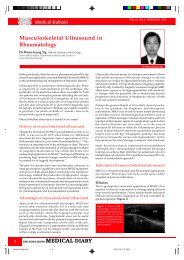MEDICAL DIARY - The Federation of Medical Societies of Hong Kong
MEDICAL DIARY - The Federation of Medical Societies of Hong Kong
MEDICAL DIARY - The Federation of Medical Societies of Hong Kong
You also want an ePaper? Increase the reach of your titles
YUMPU automatically turns print PDFs into web optimized ePapers that Google loves.
6<br />
<strong>Medical</strong> Bulletin<br />
<strong>The</strong> following Table 1 is very simple, straight forward<br />
and useful for clinical use:<br />
Table 1<br />
System<br />
Cardiac<br />
Vascular<br />
Pulmonary<br />
Gastrointestinal<br />
Musculoskeletal Costochondritis<br />
Infectious<br />
Psychological<br />
Syndrome<br />
Angina<br />
Unstable angina<br />
Myocardial<br />
Infarction<br />
Pericarditis<br />
Aortic Dissection<br />
Pulmonary<br />
Embolism<br />
Pulmonary<br />
Hypertension<br />
Pleuritis &/or<br />
pneumonia<br />
Tracheobronchitis<br />
Pneumothorax<br />
Oesophageal<br />
reflux<br />
Peptic ulcer<br />
Gallbladder<br />
Disease<br />
Pancreatitis<br />
Cervical Spinal<br />
Disease<br />
Rib<br />
Trauma/Strain<br />
Herpes Zoster<br />
Panic disorder<br />
Clinical Description<br />
Character:<br />
pressure, burning,<br />
heaviness, for 1 -3 mins<br />
Location: Retrosternal,<br />
Radiation to neck, jaw,<br />
epigastrium, shoulders,<br />
left arms (ulnar side)<br />
As above, more severe<br />
As above, more severe<br />
Sharp, Pleuritic pain,<br />
aggravate by change in<br />
position, swallowing,<br />
breathing, variable<br />
duration, may locate in<br />
shoulders, neck, back,<br />
upper abdomen<br />
Excruciating, ripping<br />
pain, sudden onset,<br />
anterior (ascending),<br />
radiate to back<br />
(desending)<br />
Sudden SOB, pleuritic<br />
pain (pulmonary<br />
infarct), substernal pain<br />
(pulmonary artery<br />
distention),<br />
substernal pain with<br />
exertion<br />
Pleuritic pain, short<br />
duration, over involved<br />
area<br />
Mid-line Burning<br />
Sudden, unilateral,<br />
pleuritic, SOB<br />
Burning substernal and<br />
epigastric discomfort<br />
10-60mins in duration<br />
Prolonged epigastric<br />
and substernal burning<br />
60-90mins after meals<br />
Prolonged epigastric,<br />
RUQ pain<br />
Prolonged, intense,<br />
epigastric and<br />
substernal burning<br />
Sudden, intense, sharp,<br />
pin-prick, stabbing,<br />
Fleeting (Tietze<br />
syndrome)<br />
Sudden, fleeting pain<br />
Constant pain<br />
Prolonged burning pain<br />
in dermatomal<br />
distribution<br />
Chest tightness,<br />
associated with<br />
dizziness, SOB, Limb &<br />
circumoral numbiness,<br />
great fear <strong>of</strong> but never<br />
suffering from "LOC<br />
and dying"<br />
Key differentiation<br />
Features<br />
Precipitated by:<br />
full stomach,<br />
exercise, cold<br />
weather, emotional<br />
stress<br />
3 -20 mins in<br />
duration<br />
Low exercise<br />
tolerance<br />
Sudden onset, ><br />
30mins in<br />
duration,<br />
Associate with<br />
SOB, Dizziness,<br />
Sweating, nausea,<br />
vomiting,<br />
peri/syncope<br />
Pericardial friction<br />
rub<br />
Very severe pain,<br />
In patients with<br />
hypertension,<br />
pregnancy, Marfan<br />
Syndrome<br />
SOB, Tachycardia,<br />
right heart failure<br />
SOB, right heart<br />
failure<br />
Lateral, with SOB<br />
coughing<br />
Sudden pain and<br />
SOB<br />
Precipitated by<br />
large meal and<br />
postprandial lying<br />
down, relieved by<br />
antacid<br />
Relieved by<br />
antacid and food<br />
Following meal<br />
Associated with<br />
alcohol,<br />
hypertriglyceridaemia<br />
Reproduced by<br />
pressure over<br />
affected joint<br />
Reproduced by<br />
neck movements<br />
Reproduced by<br />
palpation or<br />
movement <strong>of</strong> chest<br />
wall or arms<br />
Vesicular rash in<br />
dermatomal<br />
distribution,<br />
day 1 - day 2 after<br />
pain onset<br />
Symptoms <strong>of</strong><br />
Anxiety, Anxiety<br />
depression<br />
VOL.14 NO.1 JANUARY 2009<br />
Apart from my table above, there are two very simple<br />
but useful guidelines for your daily clinical use.<br />
1. National Heart Attack Alert Programme 1994' 7<br />
Chief Complaints that indicate the immediate need <strong>of</strong><br />
medical & cardiac care:<br />
Chest pain, pressure, tightness or heaviness; pain<br />
that radiates to neck, jaw, shoulders, back, or one or<br />
both arms<br />
Indigestion or heartburn; nausea and/or vomiting<br />
associated with chest discomfort<br />
Persistent shortness <strong>of</strong> breath<br />
Weakness, dizziness, lightheadedness, loss <strong>of</strong><br />
consciousness<br />
2. ACC/AHA Guidelines Update for <strong>The</strong><br />
Management <strong>of</strong> Patients with Unstable Angina<br />
and Non-ST-segment Elevation Myocardial<br />
Infarction-2002' 8<br />
Pain not characteristic <strong>of</strong> angina<br />
Sharp/knife - like pain with respiration/cough<br />
(Pleuritic Pain)<br />
Primary mid/lower abdominal discomfort<br />
Pain can be localised at the tip <strong>of</strong> one finger,<br />
especially over the left ventricular apex<br />
Moreover, chest pain in women is more difficult to<br />
assess even with non-invasive tests. Very careful<br />
history and risk assessment are our key to success.<br />
Before thinking about investigations, before reaching a<br />
definite diagnosis, before the planning <strong>of</strong> immediate<br />
management and before thinking about the prognosis...,<br />
we must first ask ourselves the followings three life<br />
saving questions:<br />
1.<br />
What is the clinical stability <strong>of</strong> the patient?<br />
- Does the patient need immediate resuscitation for<br />
circulatory and/or respiratory collapse?<br />
- If the answer is Yes<br />
- Advanced Cardiac Life Support (ACLS) / Basic<br />
Cardiac Life Support (BCLS) in your clinic then,<br />
- Transfer the patient to a private/public hospital as<br />
soon as possible.<br />
If the patient is clinically stable, then ask...<br />
2.<br />
3.<br />
What is the immediate prognosis <strong>of</strong> the patient?<br />
- What is the risk that the patient is suffering from<br />
life-threatening conditions, eg. ACS, aortic<br />
dissection, pulmonary embolism?<br />
- If is answer is Yes again...<br />
- Transfer to a private/public hospital as soon as<br />
possible<br />
What is the degree <strong>of</strong> the safety <strong>of</strong> referral<br />
- If the risk <strong>of</strong> life-threatening conditions are low,<br />
would it be safe to discharge the patient for<br />
private specialist (may need to wait for hours to<br />
days) or<br />
public specialist (may need to wait for days up to<br />
years) or<br />
should we (as a family doctor) directly refer the<br />
patient for further investigation and /or observation<br />
to guide for further management?

















